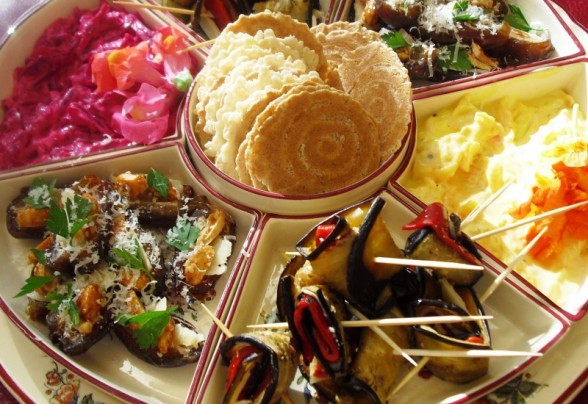When I was a kid I insisted on my birthday dinner at New York’s now defunct Trader Vic’s. I loved their pupu platter followed by beef steak teriyaki. PuPu is a Chinese-American phenomenon originating in Hawaii, loosely translated it means “snail” or “small bites.”
Traditionally it is very meat and seafood heavy. Crab rangoon, skewered beef sticks, spare ribs and fried shrimp are commonly found. In any event, the pupu platter is a fond memory from my childhood. So while these appetizers share no resemblance to traditional pupu platter delicacies, I still refer to my hors d’oeuveres as pupu platters. Here are a few of my new vegetarian favorites.
Recipes for Kale chips abound on the internet. I’ve tried my fare share and have finally settled on the following procedure. I prefer to use Lacinto – or Dino Kale but you can use any kale you wish. Just make sure to adjust the cooking time and go easy on the salt.
Using a rack over a cookie sheet makes for an overall crispier chip.
Slow and Low is Best
225 degrees, with convection if you have it, for 30 to 40 minutes. You can make them more quickly at 350 degrees but the color isn’t as good and they just aren’t as tasty.
Additives
Store bought kale chips have a slurry or paste added to them so that they become stronger and don’t break a part as much. Making homemade kale chips allows for a more refined chip.
My favorite add-ons are freshly grated garlic, lemon zest or both. Use a micro plane grater to get the finest dust onto the kale. Experiement with spices -I love the lemony flavor of coriander, but curry and other spice blends are equally delicious.
Less is more when it comes to salt and olive oil on kale chips. I usually only use about 2 Tbsp. of olive oil and a scant 1/8 tsp. of salt for a large bunch of Lacinto.
Don’t use much more. You can always add a Flavorista fave of Maldon’s Smoked Sea Salt Flakes at the end.
Raw Cashew Hummus While making cashew and almond milks for The Forager Project, I couldn’t bare to toss the cashew “meat” that is left from pressing the liquid out through cheese cloth. This spread is pretty versatile and oh so creamy. You don’t have to make cashew milk to enjoy it.
Simply take 2 cups of raw cashews (this is important, roasted won’t work) and soak overnight in 3 cups of water. Drain the water off and place the soft cashews in the bowl of a food processor (A blender will work but you will have a chunky “hummus” versus something creamy. Add a clove of garlic, the juice of 1 to 2 lemons (depending on your taste), and some zest from same lemon. Limes are also a good choice. Start to process and then while the machine is running add some olive oil. You can thin the mixture out with water. Season with salt and pepper or any other spices you might like. Serve with any type of cracker or bread. It also makes a wonderful substitute for cheese in sandwiches.
Peppadews Stuffed with Goat Cheese
These bites are an easy go to when you’re in a pinch. Peppadews come in jars but I’ve seen both the red and yellow ones on the olive bar at Whole Foods. 

Stuffed with goat cheese they add a colorful, creamy and zesty mouthful. Any soft goat cheese will do but I really like Boulder based Haystack Mountain’s herb enrobed log. Just pinch off a chunk and place it in the center of the peppadew. If you want to get fancy. garnish is with a fresh chive snippet or a fresh parsley leaf.
For more vegetarian pupu platter recipe ideas, click here.




No comments yet.